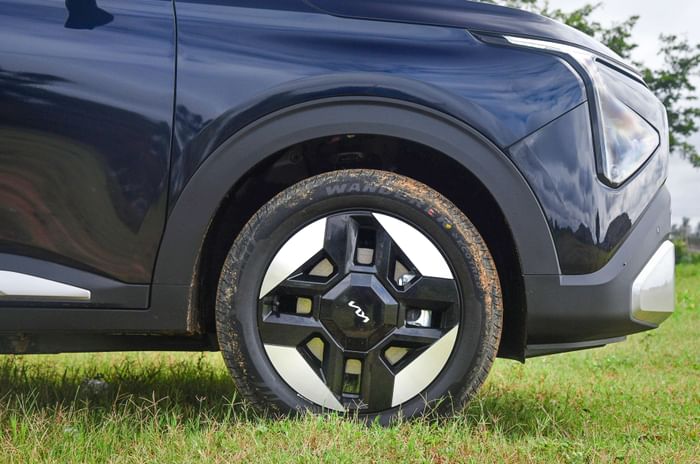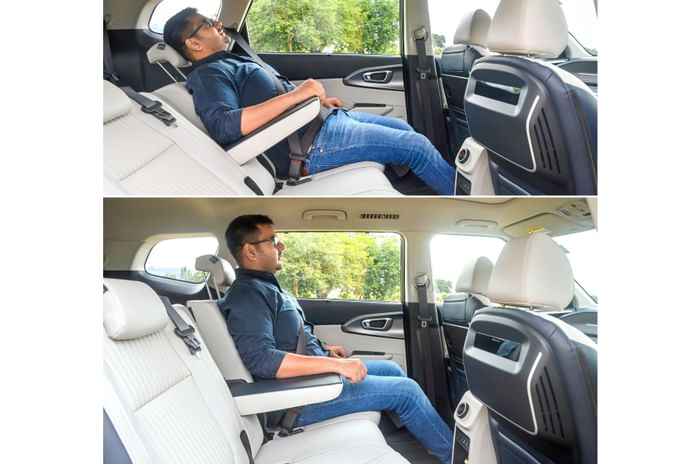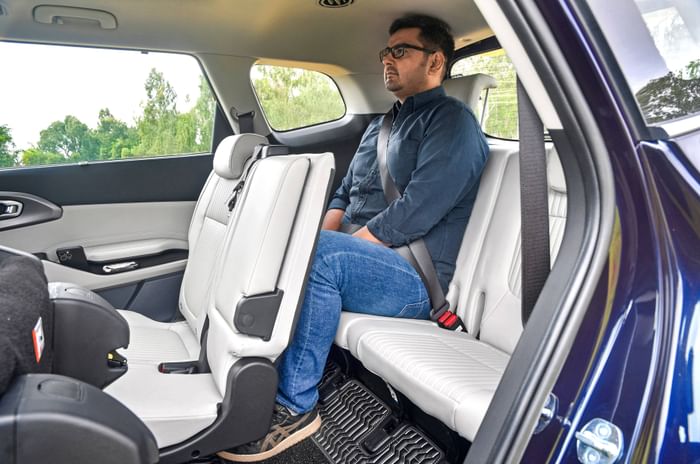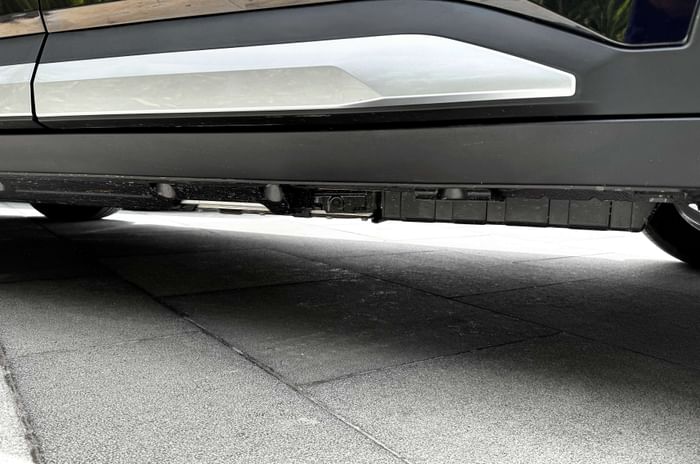Kia has quickly followed up the Carens Clavis’ petrol and diesel powertrains with an electric derivative. Could it be the Clavis to buy?
What we have here is Kia’s first mass market EV for India. Lo and behold, it’s not an SUV/crossover. It’s called the Kia Carens Clavis EV and the name spells out what it is – an all-electric version of the Clavis. The experience, as you’ll learn, is familiar yet different.
Kia Carens Clavis EV exterior design and engineering – 8/10
Subtle tweaks help distinguish Clavis EV from its ICE sibling.
A green number plate will be the biggest indicator that the Carens Clavis you are looking at is indeed the EV version. Kia hasn’t tinkered with the MPV’s design in any way but there are some EV-specific style tweaks.
Kia hasn’t tinkered much with the MPV’s design on this EV version.
The light bar above the grille glows (it doesn’t on petrol/diesel versions), the charging flap sits at the centre of the nose, while the revised bumper is home to active aero elements (they open/close as needed), ‘ice cube’-look fog lamps and a redone scuff plate. The EV’s bonnet also lifts to reveal a 25-litre frunk, which can be used to stow charging cables. An aero-optimised look for the 17-inch wheels is also unique to the Clavis EV while the changes at the back are limited to the new EV badging.

17-inch alloys get a new aero-optimised design.
Under the skin, the Kia Carens Clavis EV has much in common with the Hyundai Creta Electric. Like the Creta Electric, the Clavis EV positions its battery pack in the wheelbase. On offer are 42kWh and 51.4kWh battery pack versions, with the former paired with a 135hp/255Nm motor and the latter a more powerful 171hp/255Nm unit; both are front-mounted and front wheel-drive.
Kia Carens Clavis EV interior space and comfort – 8/10
Well packaged battery means no compromise in space or seating comfort.
If you’ve been in a Clavis, you’ll be at home in a Clavis EV. The basic look inside is shared with a smartly finished dash sporting a twin-screen arrangement. The EV does distinguish itself with a floating look for the console between the front seats. The console serves as an armrest, packs in cupholders and is also home to buttons for features like seat ventilation. There’s open storage below it, and in general, the cabin has an airy feel.
.jpg)
Interior remains largely unchanged from Clavis except for a new floating centre console design.
Getting in and out of the Clavis EV is easy and drivers will like their seat for comfort and adjustability – the seats get partial power adjust while the steering adjusts for rake and reach. The steering itself is nice to hold with nice paddles and a chunky drive mode selector button.
What’s nice is how well the battery pack has been accommodated in the body. The middle row seating position doesn’t feel too different to the ICE versions’, so you don’t get that knees-up position we’ve come to expect in EVs that position their battery pack under the floor.

The middle row is comfy and scores really well on flexibility.
The middle row is comfy and scores really well on flexibility. The seats split 60:40, can be slid back and forth and also get generous backrest recline. There’s also a powered adjust to move the front passenger seat forward to free up more room for the boss seat. Do note, the Clavis EV is only offered in 7-seat form and doesn’t get the option of captain’s chairs for the middle row.
Getting to the third row is an easy affair thanks to a one-touch powered seat fold function that opens up a large walk through. The rearmost seats are suitable for average-sized adults and it’s easy to work out a space compromise with the middle seat passengers.
 Third row seats are adequate for two average-sized adults.
Third row seats are adequate for two average-sized adults.
With all seats up, there’s space for a few soft bags in the boot. The third and second rows can be folded flat to create more luggage room as required.
Kia Carens Clavis EV performance and refinement – 8/10
Performance is brisk and there’s ample pulling power even when loaded.
| Kia Carens Clavis EV specs | ||
|---|---|---|
| Standard | Extended Range | |
| Battery | 42kWh | 51.4kWh |
| Drive layout | Front, single motor | Front, single motor |
| Power | 135hp | 171hp |
| Torque | 255Nm | 255Nm |
Featured here is the Clavis EV in its larger battery and more powerful Extended Range guise. Like other EVs, the experience in the cabin is quiet. There is little you hear of the motor up front and even road and wind noise are well contained.
Even at part throttle, the Clavis EV has a nice reserve of power.
MPVs aren’t typically about performance so you’ll be pleasantly surprised by the Clavis EV’s build of speed. Kia claims an 8.4-second 0-100kph time, which is suitably brisk. There’s a strong pull should you press down on the accelerator and this, for instance, makes overtaking very easy. There’s ready power even at part throttle and you’ll rarely, if ever, need to dial up to Sport mode. The default Normal setting works just fine and even Eco is more than sufficient for everyday commutes. There’s enough poke even with all three rows occupied and even the climb up to Nandi Hills was easy going for the Clavis EV.
Kia Carens Clavis EV efficiency/range – 7/10
Carens Clavis EV has an official range of up to 490km.
| Kia Carens Clavis EV range and charging | ||
|---|---|---|
| Standard | Extended Range | |
| Battery | 42kWh | 51.4kWh |
| Claimed range (ARAI) | 404km | 490km |
| 11kW AC charging (10-100%) | 4 hours | 4 hours 45 mins |
| DC charging (10-100%) | 39mins | 39mins |
The Carens Clavis EV with the 42kWh battery pack has an official range of 404km while the larger 51.4kWh battery pack boasts a 490km official range figure.
Over our test drive, the Clavis EV Extended Range delivered a real-world figure in the region of 320-350km (depending on mode). The caveat here is that our drive route included a run up to Nandi Hills, and inclines really sap battery charge. We’ll wait to test the Clavis EV in Mumbai on our efficiency test loop before delivering final judgement on how far it can go on a full charge.
Extended Range variant has an ARAI-certified range of 490km.
The Clavis EV supports DC charging at up to 100kW that enables a 10-80 percent charge in 39 minutes. Worth highlighting is that Kia is establishing a network of these fast chargers at its dealerships for times when you need a quick top up charge. Ultimately, it’s the spread of high-speed chargers pan India that will determine how far and freely you can travel with a Carens EV.
For the majority of owners, a 11kW AC charger (supplied with the car) set up at home or your work place will be the go to solution to juice up the Clavis EV’s battery pack. A 10-100 percent charge takes 4 hours for the 42kWh version and 4 hours and 45 minutes for the 51.4kWh version.
Kia Carens Clavis EV ride comfort and handling – 7/10
Easy-to-drive demeanour complemented by pleasant ride comfort.
We’ve always liked the Carens (and now Clavis) for its friendly manners and that’s no different on the Clavis EV. For one, the Clavis EV doesn’t intimidate anyone upgrading from a smaller vehicle. The light steering, great visibility and the crisp cameras help to this end.
There’s a slight hint of firmness, but ride comfort is good overall.
Kia has retuned the suspension to deal with the added weight of the battery pack, and it’s a job well done. Ride comfort is good for the most part, and it’s only when getting off sharp speedbreakers that you’ll notice the Clavis EV slam down on its springs before settling quickly. You’ll feel a hint of firmness if you really pay attention to the happenings beneath. The Clavis EV offers 200mm of unladen ground clearance and the body or battery pack didn’t make contact with the ground even over broken patches. At higher speeds, the Clavis EV feels composed and surefooted.

Despite the battery pack sticking out, it didn’t make any contact with the ground on our drive.
Braking performance is also good with reassuring stopping power. Regen braking that uses the motor to slow the vehicle down, and feed some of the recovered energy back to the battery, is part of the package. Regen strength can be toggled via paddleshifters and there are four settings: off, mild, mid and strong. You get one-pedal driving (ability to bring the car to a halt using regen) in the strongest setting, though the drop in speed towards the end could be more urgent. What’s nice is how well the regen works with ADAS functions like adaptive cruise control to modulate speed.
Kia Carens Clavis EV price and verdict – 8/10
Pricey at the top end but an EV that fits the bill for large families.
The Clavis EV is a very likeable product offering. It has all that we like about the Clavis and all that we like about EVs in one competent package. High mileage users (as many MPV owners tend to be), in particular, will be tempted by the move to electric given the savings in running costs. There is a price to pay, though, and that is in upfront costs.
.jpg)
The Clavis EV is the only three-row EV in the Rs 20 lakh-25 lakh price range.
Kia has launched the Clavis EV at Rs 17.99 lakh with the range-topping version featured here priced at Rs 24.49 lakh (ex-showroom). That’s Rs 3 lakh over a similarly equipped Carens Clavis turbo-petrol with a DCT. Incentives and registration benefits on EVs do reduce the on-road price delta, at least for the moment.
Thing is, there’s no other 7-seat EV at this price point. The only other 3-row EV is BYD’s eMax 7 that costs a few lakhs more. The Clavis, then, is actually an alternative to the increasing number of electric SUV options in the Rs 20 lakh-25 lakh band. For anyone keen on an EV and with regular use for three rows, the Clavis EV is really the only choice. And a very good one indeed.
Also See:
Kia Carens Clavis EV video review
Tata Harrier EV review: Electrifying update